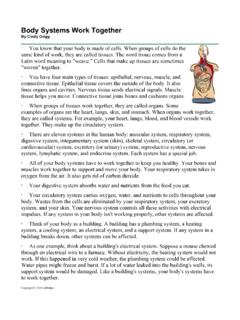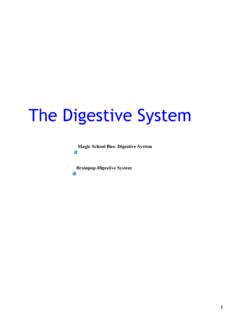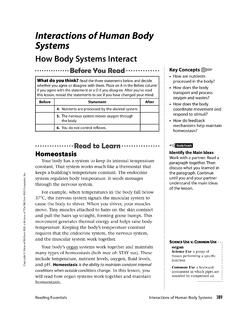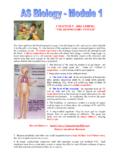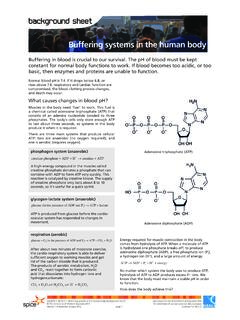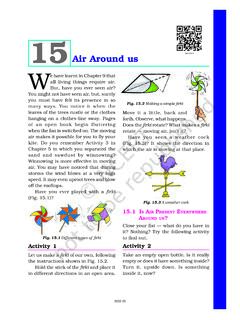Transcription of LESSON 3.1 - AN INTRODUCTION TO RESPIRATION
1 Unit: Biology E - RESPIRATION Science 21 Bio E - RESPIRATION B129 LESSON - AN INTRODUCTION TO RESPIRATION Overview: Students will share any experiences that they may have had with respiratory illness or distress, brainstorm what they know and would like to learn about the respiratory system , and complete an introductory vocabulary, reading and question package. Suggested Timeline: hours Materials: Reflections on the respiratory system (Student Handout) An INTRODUCTION to RESPIRATION (Student Handout) Method: INDIVIDUAL FORMAT: 1. Have students complete Reflections on the respiratory system (Student Handout) and submit their sheet. Use the information about what students would like to learn about the respiratory system as a guide for extensions to this section of the human systems unit.
2 2. Have students complete the vocabulary, reading and question package An INTRODUCTION to RESPIRATION (Student Handout). GROUP FORMAT: 1. Have students complete Reflections on the respiratory system (Student Handout). 2. Have students share their information with the class and begin a discussion. Tidbits of information to share: We breathe 13 pints of air each minute. More than half a lifter of water is lost per day through breathing. People who are 30 take in double the oxygen compared to a person who is 80. Source: The right lung is slightly larger than the left lung The surface area of the lungs is roughly the same size as a tennis court.
3 Source: 3. Use the information about what students would like to learn about the respiratory system as a guide for extensions to this section of the human systems unit. 4. Have students complete the vocabulary, reading and question package An INTRODUCTION to RESPIRATION (Student Handout) and review in class. Assessment and Evaluation: Assessment of student s prior knowledge and understanding of the respiratory system Assessment of quality of students answers to questions in handout Student grade on quiz Extension: Build a concept map for the respiratory system section of this unit Unit: Biology E - RESPIRATION Name: _____ Date: _____ Student Handout ON THE respiratory system Think of a time when you had a cold or another, and possibly more serious, health issue that affected your ability to breathe.
4 Describe how it felt. Complete the first two columns of the chart. What do you know about the respiratory system ? What do you want to learn about the respiratory system ? What did you learn about the respiratory system ? Science 21 Bio E - RESPIRATION B130 Unit: Biology E - RESPIRATION Name: _____ Date: _____ Period: _____ Student Handout An INTRODUCTION to RESPIRATION VOCABULARY RESPIRATION breathing trachea bronchi alveoli PART I: What is Breathing and RESPIRATION ? All living things need energy to live you, bacteria, grass and dogs! Energy is needed for the cells in your body to function to keep you alive.
5 Living things get energy the same way your car gets its energy - by burning a fuel. In a car, energy is released when oxygen from the air combines with the gasoline in the engine. In animals, oxygen is combined with food that has been broken down and energy is released. This life process is called RESPIRATION . RESPIRATION is the release of energy by combining oxygen with digested food (glucose). Here is what happens: digested food + oxygen energy and waste products RESPIRATION can also be shown in this way: Glucose (fuel) + oxygen energy + water (waste) + carbon dioxide (waste) In many animals, breathing is done by the action of the lungs. Breathing in is taking air into the lungs and forcing the air out of your lungs.
6 Breathing and RESPIRATION are related, but they are not the same. Breathing is the action of air going into and out of your lungs. RESPIRATION is using the oxygen in that air to release energy from the food that you eat. Science 21 Bio E - RESPIRATION B131 Student Handout Unit: Biology E - RESPIRATION Answer these questions about RESPIRATION : 1. What brings oxygen to all parts of the body? _____ 2. What does RESPIRATION make that living things need? _____ 3. What waste materials does RESPIRATION give off? _____ Breathing is an involuntary process. This means that it occurs without you having to think about it.
7 Science 21 Bio E - RESPIRATION B132 Student Handout Unit: Biology E - RESPIRATION How Does Breathing Take Happen? Why does your chest move when you breathe? Some people think that air in the lungs makes their chest move in and out. This is incorrect. It is actually the moving of your chest that makes your lungs expand and contract. Your chest size changes when you breathe because of the actions of your rib muscles and your diaphragm muscle. Choose the correct word and write it in each blank. 1. When you inhale (see Figure D), a) the ribs move _____. inward OR outward b) the diaphragm moves _____ upward OR downward c) there is now _____ space in the chest area.
8 More OR less d) air rushes _____ to fill this space. in OR out 2. When you exhale (see Figure E), a) the ribs move _____. inward OR outward b) the diaphragm moves _____. upward OR downward c) there is now _____ space in the chest area. more OR less d) because of this pressure, air moves _____ the lungs. into OR out of Science 21 Bio E - RESPIRATION B133 Student Handout Unit: Biology E - RESPIRATION What causes you to breathe? Breathing happens automatically. When the amount of carbon dioxide in your blood increases to a certain level, a message is sent to your brain.
9 Your brain then sends a message to your diaphragm and rib muscles to increase the size of your chest cavity. This causes air to move into the lungs. Each of the following goes with either inhaling or exhaling. Place a checkmark in the box where you think each statement belongs. Adapted from What is Breathing and RESPIRATION ?, pp. 90-94 Biology Science Workshop Series PART II: What is the respiratory system ? Almost all living things (except some bacteria) need oxygen to live. The lungs are the organs involved with breathing. They are the main organs that make up the respiratory system . The function of the respiratory system is to take oxygen into the lungs and to get rid of water and carbon dioxide.
10 Science 21 Bio E - RESPIRATION B134 Student Handout Unit: Biology E - RESPIRATION This is the path that air takes when you inhale and exhale: 1. Air enters the body through the nose or mouth. 2. The air moves goes into the throat and passes through the windpipe or trachea. 3. The trachea divides into two tubes called bronchi. Each bronchus extends into one of the lungs. 4. Inside of the lungs, the bronchi branch into smaller and smaller tubes. At end of the smallest tubes are air sacs called alveoli. Each alveolus is surrounded by capillaries. When the air is in the air sacs or alveoli, two important things happen: The blood picks up oxygen from the alveoli.

